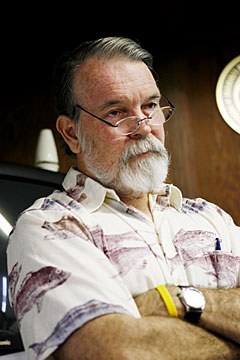
GEORGE F. LEE / GLEE@STARBULLETIN.COM
Fingerling moi, raised at the aquaculture farm at the Oceanic Institute at Makapuu, is one of the species that has thrived in offshore aquaculture operations.
|
|
Promise of the sea
Hawaii leads in the emerging practice of farming fish offshore
WITH JUST TWO offshore fish farms, Hawaii is at the forefront of an emerging industry, said members of a national task force that met on Oahu last week.
"Hawaii is leading the country in development of offshore aquaculture," said Bruce Anderson, Oceanic Institute president and a member of the Marine Aquaculture Task Force. "It's been done well here, with minimal environmental impact."
The nine-member task force met at the Oceanic Institute in Waimanalo on Thursday and Friday, discussing its recommendations for aquaculture guidelines in federal waters, three to 200 miles from shore.
The task force was formed last fall to produce recommendations for Congress and the National Oceanic and Atmospheric Administration by late summer, said its chairman, Dick Pittenger, a former research coordinator for the Woods Hole Oceanographic Institution and former Navy rear admiral.
 "Aquaculture will be the dominant producer of aquatic protein in the 21st century. If you don't believe that, then you're not paying attention."
John Corbin
Head of the state Department of Agriculture's aquaculture program
"Aquaculture will be the dominant producer of aquatic protein in the 21st century. If you don't believe that, then you're not paying attention."
John Corbin
Head of the state Department of Agriculture's aquaculture program
|
Legislation introduced last year by Sens. Daniel Inouye, D-Hawaii, and Ted Stevens, R-Alaska, seeks to open federal waters to marine aquaculture, but hasn't been scheduled for hearings.
The task force's charge is: "If you're going to have this law, what standards are needed to ensure that it's done in an environmentally sustainable manner?" Pittenger said.
While there is substantial farming of shellfish and salmon in U.S. mainland coastal waters, Hawaii entrepreneurs are the first in the country to deploy submerged cages to raise fish in deeper offshore waters.
Cates International Inc. raises moi (Pacific threadfin) two miles from Ewa Beach, and Kona Blue Water raises its trademarked kahala -- Kona Kampachi -- about a half-mile offshore from Kailua-Kona on the Big Island.
Both operations are in state waters. But because the depth of the ocean off Hawaii drops off more quickly than continental shorelines, the conditions for the two farms closely resemble those in federal waters, said John Corbin, head of the state Department of Agriculture's aquaculture program.
"Aquaculture will be the dominant producer of aquatic protein in the 21st century," Corbin said in a presentation to the task force Friday. "If you don't believe that, then you're not paying attention."
"Hawaii has the oldest aquaculture in the U.S. (Hawaiian fish ponds) and we definitely want to see aquaculture develop," Corbin said. He hopes the state will see as many as 10 open-water farms in the coming decade.
In 2004 the U.S. imported seafood worth $11.2 billion from other countries and exported $3.7 billion, leaving it with a $7.5 billion seafood trade deficit, according to the U.S. Department of Commerce.
Corbin said the Cates and Kona Blue operations illustrate how deeper water and current movement disperse fish waste and excess fish feed so they don't cause water pollution problems.
Salmon farming, which is done in cages floating at the surface of bays and other nearshore waters, has raised concern about water pollution, escaping fish that are biologically different than wild fish, and the spread of disease from farmed fish to wild fish, said Rebecca Goldburg, a task force member and a senior scientist for Environmental Defense, a research and advocacy organization.
Aquaculture that's sustainable on a small scale may not be viable in large-scale applications, Goldburg cautioned, pointing to pollution problems from large "factory farm" livestock operations on land.
"NOAA has said it wants a $5-billion-a-year U.S. aquaculture industry," Goldburg said. "What's the cumulative impact of that industry?"
The Marine Aquaculture Task Force includes scientists, former government regulators and legislators, aquaculture business people and environmentalists.
Its expenses -- expected to be about $500,000 -- are being paid by the Pew Charitable Trusts, the same group that funded a huge study of U.S. ocean policy in 2003. That study recommended: improving the management of the nation's commercial fisheries, establishing networks of marine reserves in coastal waters, increasing the involvement of the Army Corps of Engineers in environmental restoration, applying strong environmental standards to fish farms and regulating the discharge of waste by cruise ships.

